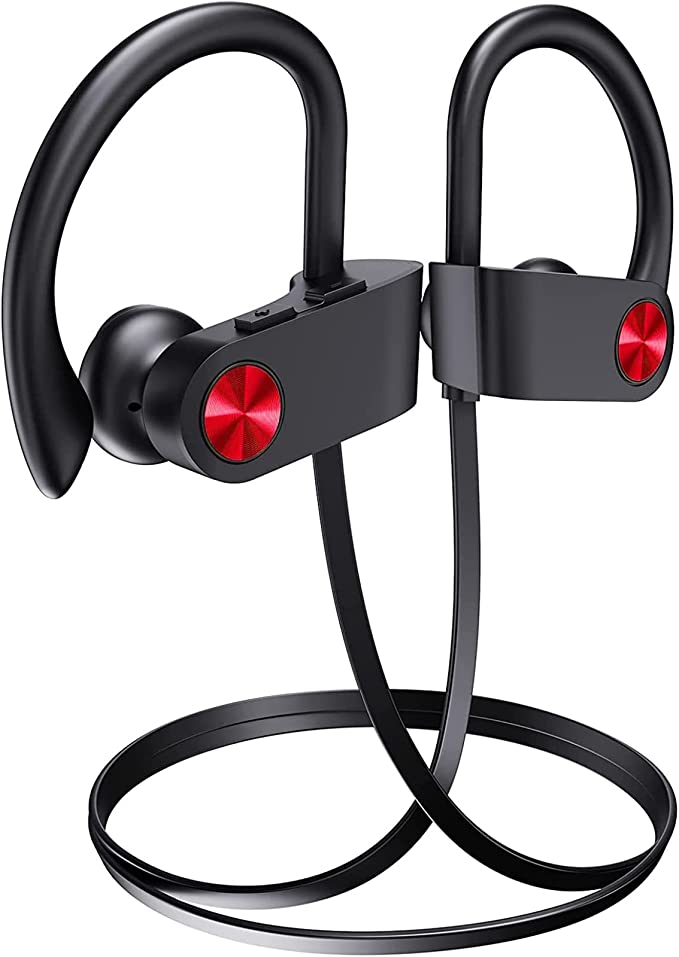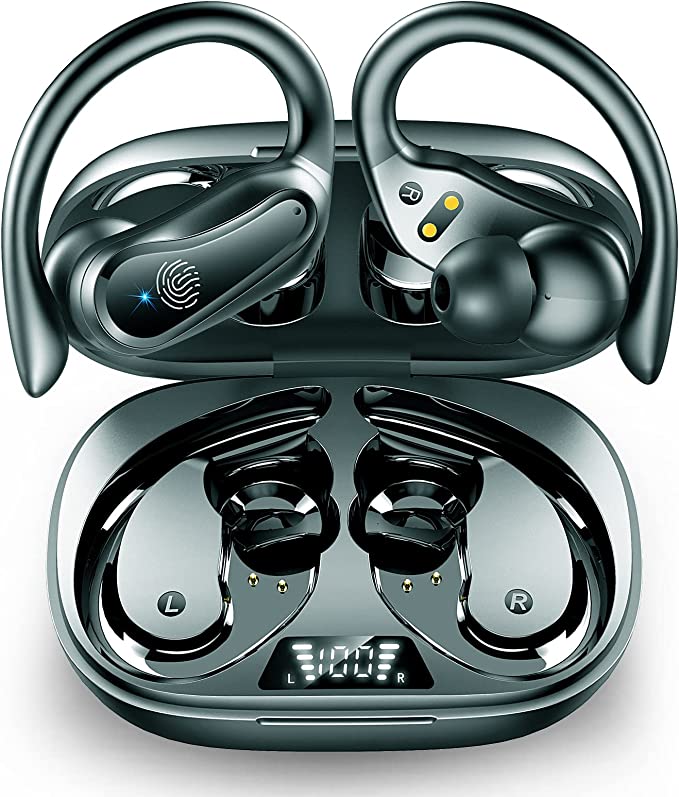In our world awash with wireless signals and portable gadgets, headphones have become almost an extension of ourselves. We rely on them for music that motivates our workouts, podcasts that enlighten our commutes, and clear calls that connect us across distances. Yet, alongside this convenience often walks a familiar shadow of frustration: the dreaded low-battery warning cutting short a song, the connection sputtering during an important conversation, or the worry of a sudden downpour ruining our precious tech.
Enter devices like the Rythflo WH03 Wireless Headphones. On the surface, presented through its Amazon listing, it offers a compelling list of features: an almost unbelievable 150-hour playtime, robust IPX7 water resistance, and the latest Bluetooth 5.3 connectivity, all wrapped in a practical neckband design. But as an engineer who spends her days wrestling with the physics and compromises behind such technology, I see more than just bullet points. I see a case study in the intricate dance of power management, acoustic engineering, wireless communication, and material science that makes modern personal audio possible.
So, let’s put on our proverbial lab coats and peer beyond the marketing claims. Using the provided specifications as our blueprint and drawing upon established scientific and engineering principles, we’ll explore the how and why behind the Rythflo WH03’s capabilities. It’s important to note upfront: our primary data source is the manufacturer’s own description. We aren’t independently testing these claims, but rather examining the underlying science that could make them feasible.

The Power Core: Engineering for Endurance
The specification that immediately jumps out is the 150-hour playtime. In an era where many true wireless earbuds measure their life in single-digit hours, this figure seems almost fantastical. How could such endurance be achieved? It boils down to a synergy of energy storage and energy efficiency.
Think of the battery as the device’s energy backpack. Modern electronics like the WH03 almost certainly employ Lithium-ion or Lithium-polymer batteries. These chemical powerhouses are favored for their high energy density, meaning they can pack a lot of electrical charge into a relatively small and lightweight package. Here, the neckband form factor plays a crucial, often underestimated role. Unlike tiny earbuds where every millimeter is contested space, a neckband offers significantly more volume to house a physically larger battery cell, directly translating to a higher potential energy capacity. It’s simple physics: a bigger backpack can carry more provisions.
But having a large backpack is useless if you’re constantly leaking energy. This is where the efficiency engine comes in, significantly powered by Bluetooth 5.3. Each generation of Bluetooth strives for better power management, and version 5.3 incorporates refinements designed to minimize energy consumption, especially during idle periods or low-intensity transmissions (foundational elements related to LE Audio). It allows the headphones to ‘sip’ power rather than ‘gulp’ it, stretching the battery’s reserves over an extended period. This meticulous power management is also key to the claimed three-month-plus standby time, requiring incredibly low quiescent current – the power drawn even when the device appears ‘off’.
Complementing the marathon endurance is the Rapid Refuel capability: a purported 15 hours of listening from just 10 minutes of charging via its USB-C port. This isn’t magic; it’s controlled high-speed power delivery. Fast charging protocols essentially increase the voltage or current (or both) flowing into the battery, dramatically speeding up the initial charging phase. Imagine filling a water bottle: fast charging uses a wide-mouthed hose for the first, say, 80%, then slows down to carefully top it off without spilling or damaging the container. The versatile USB-C standard is instrumental here, designed to negotiate and handle these higher power levels safely, managed by sophisticated circuitry both in the headphones and potentially the charger, preventing overheating and protecting the battery’s long-term health. While incredibly convenient, it’s worth remembering a general principle: consistently pushing batteries to their charging limits might subtly influence their overall lifespan compared to slower, gentler charging, though modern battery management systems are designed to mitigate this significantly.

Crafting Sound: The Art and Science of the 13mm Driver
Endurance is vital, but headphones exist to deliver sound. The WH03 utilizes 13mm audio drivers. What does this mean? The driver is the heart of the headphone, the miniature speaker responsible for converting electrical signals back into the sound waves that reach our ears. Think of it as a tiny, precision instrument. It typically consists of a diaphragm (a thin membrane), a voice coil attached to it, and a magnet. When the electrical audio signal flows through the voice coil within the magnetic field, it causes the coil and the attached diaphragm to vibrate rapidly, pushing air and creating sound waves.
Does size matter? In driver design, it certainly influences potential performance. A larger diaphragm, like the 13mm one specified here, has a greater surface area. This allows it to move more air with each vibration compared to a smaller driver. Generally, this translates to a greater potential for producing low-frequency sounds (bass) with authority and achieving higher overall volume levels without distorting. The manufacturer describes the audio profile as “powerful, balanced sound” with “rich bass and enhanced clarity.”
However, achieving truly “balanced sound” is as much art as science. It’s the goal of acoustic tuning, ensuring that bass, midrange, and treble frequencies are reproduced faithfully without any single part overshadowing the others. While the 13mm driver provides a capable physical foundation, the final sound signature – whether it truly sounds “balanced,” “rich,” or “clear” – depends heavily on intricate tuning choices made by the engineers, the materials used for the diaphragm (which aren’t specified), and the acoustic design of the earbud housing itself. Sound perception is also inherently subjective; what one person finds balanced, another might perceive as bass-heavy or too bright. The inclusion of multiple ear tip sizes (we’ll discuss those later) also plays a critical role, as a good seal is paramount for optimal bass delivery.

The Invisible Tether: Untangling Bluetooth 5.3
The connection between your device and the headphones is handled by Bluetooth 5.3. Why should you care about the version number? Because each iteration brings tangible, albeit sometimes subtle, improvements to the wireless experience.
Compared to its predecessors (like BT 5.0 or 5.2), Bluetooth 5.3 offers several key advancements relevant here:
* Smoother Conversations: It boasts enhanced channel classification and other features aimed at reducing interference, especially in crowded radio frequency environments (think busy offices or gyms). This translates to more stable connections and fewer annoying audio dropouts.
* Faster Lane (Potentially): While the actual audio quality heavily depends on the supported codecs (the compression/decompression algorithms like SBC, AAC, or potentially aptX – none specified for the WH03), Bluetooth 5.3 offers the underlying capability for higher data transfer rates. This creates headroom for potentially transmitting higher fidelity audio with less compression, assuming both the source device and headphones support compatible advanced codecs.
* The Efficiency Loop: As highlighted earlier, improved power efficiency is a cornerstone of BT 5.3, directly contributing to that impressive battery life.
In everyday use, these technical improvements often manifest as quicker and more reliable pairing with your phone or computer, and a generally more seamless listening experience. However, it’s worth noting a universal challenge with Bluetooth audio: latency. There’s always a tiny delay between the source device sending the audio and the headphones playing it. While BT 5.3 includes features to minimize this, some latency is inherent and might still be noticeable, particularly in fast-paced gaming or when watching videos where perfect lip-sync is critical.

Built for Life’s Spills: Decoding IPX7
Life is unpredictable. A sudden rain shower during your run, an accidental splash by the pool, or just intense sweat during a workout – moisture is a constant threat to electronics. The Rythflo WH03 counters this with an IPX7 rating. This isn’t just marketing jargon; it’s a specific standard.
Let’s break down the code: ‘IP’ stands for Ingress Protection. The first digit indicates protection against solid particles (like dust). Here, it’s ‘X’, meaning the device hasn’t been specifically rated for dust protection. The second digit, ‘7’, relates to liquid protection, and it’s quite significant. According to the International Electrotechnical Commission (IEC) standard 60529, IPX7 signifies that the device can withstand temporary immersion in water up to 1 meter (about 3.3 feet) deep for up to 30 minutes.
What does this mean practically? It makes the WH03 highly resilient against heavy sweat and rain. You can confidently wear them during intense exercise or if you get caught in a downpour. An accidental drop into a sink or puddle should also be survivable, provided it’s retrieved quickly.
However, it’s crucial to understand the limits. IPX7 does not mean the headphones are suitable for swimming. The sustained pressure and movement involved in swimming exceed the testing parameters. It also doesn’t cover exposure to high-pressure water jets or submersion beyond 1 meter or 30 minutes. Critically, while the earbuds themselves might be sealed, never attempt to charge the device if the USB-C port is wet. Always ensure the port is completely dry before plugging in the charging cable to avoid short circuits and damage.

Wearing the Tech: Ergonomics and Material Science
Beyond the internal electronics, the physical design – the neckband form factor – significantly influences the user experience. This style presents a distinct set of engineering trade-offs.
On the plus side, the neckband provides ample real estate for that large battery we discussed, crucial for achieving long playtime. It also keeps the earbuds tethered and readily accessible, dramatically reducing the chance of losing one compared to individual true wireless buds. The weight (listed as 4.66 ounces) is distributed across the neck, which many find more comfortable and stable for extended wear or during activity than having weight concentrated solely in the ears.
However, it’s not without potential drawbacks. Neckbands are inherently more visible than discreet earbuds. Some users might find the band feels slightly cumbersome or can snag on collars, as one user review briefly mentioned regarding the wire exit point potentially catching. It’s a different ergonomic proposition than the near-invisibility of true wireless designs.
The choice of silicone for the neckband (a likely material, given its common use and the description “soft silicone neckband”) leverages its excellent properties: it’s flexible, generally hypoallergenic (skin-friendly), durable, and resistant to sweat and temperature fluctuations. The simple but effective magnetic design allows the earbuds to conveniently snap together when hanging around the neck, preventing tangles and keeping them neat – likely using small, powerful neodymium magnets.
Finally, the seemingly mundane inclusion of nine pairs of eartips (three pairs each in S, M, and L sizes) is actually critical for both comfort and performance. Finding the right size creates a secure yet comfortable seal within the ear canal. This seal is paramount for several reasons:
1. Comfort: An ill-fitting tip can cause pressure or soreness over time.
2. Passive Noise Isolation: A good seal physically blocks out a significant amount of ambient noise, allowing you to focus on your audio without needing excessive volume.
3. Audio Fidelity (Especially Bass): Low-frequency sounds (bass) require this seal to be properly perceived. A poor seal allows bass energy to leak out, resulting in a thin, weak sound. Getting the fit right can dramatically improve the perceived audio quality.

The Symphony of Engineering
Looking at the Rythflo WH03 through an engineer’s lens reveals more than just a list of features. It showcases a symphony of engineering disciplines working in concert. Power management innovations borrowed from mobile computing allow for marathon battery life. Acoustic principles govern the driver design aiming for clear, impactful sound. Decades of wireless communication evolution culminate in the relatively stable and efficient connection of Bluetooth 5.3. Material science provides durable, comfortable, and water-resistant enclosures. And ergonomic considerations shape the physical form for practical, everyday use.
While based solely on manufacturer specifications, the Rythflo WH03 appears to bundle a significant amount of modern personal audio technology into an accessible package. It represents how sophisticated engineering, driven by the desire to solve common user frustrations like battery anxiety and fragility, becomes integrated into the devices that seamlessly weave themselves into the soundtrack of our lives. It’s a reminder that even in seemingly simple gadgets, there’s often a fascinating story of science and ingenuity humming away just beneath the surface.




